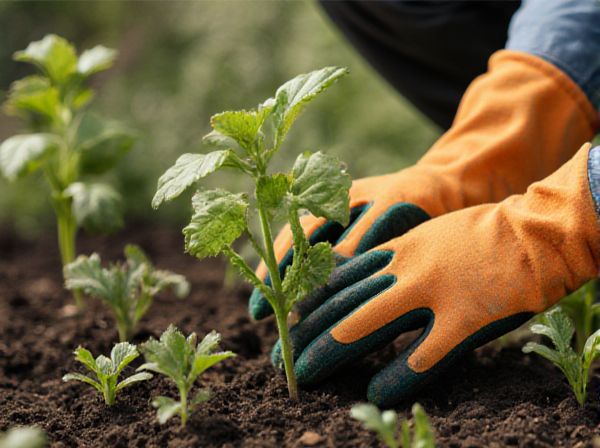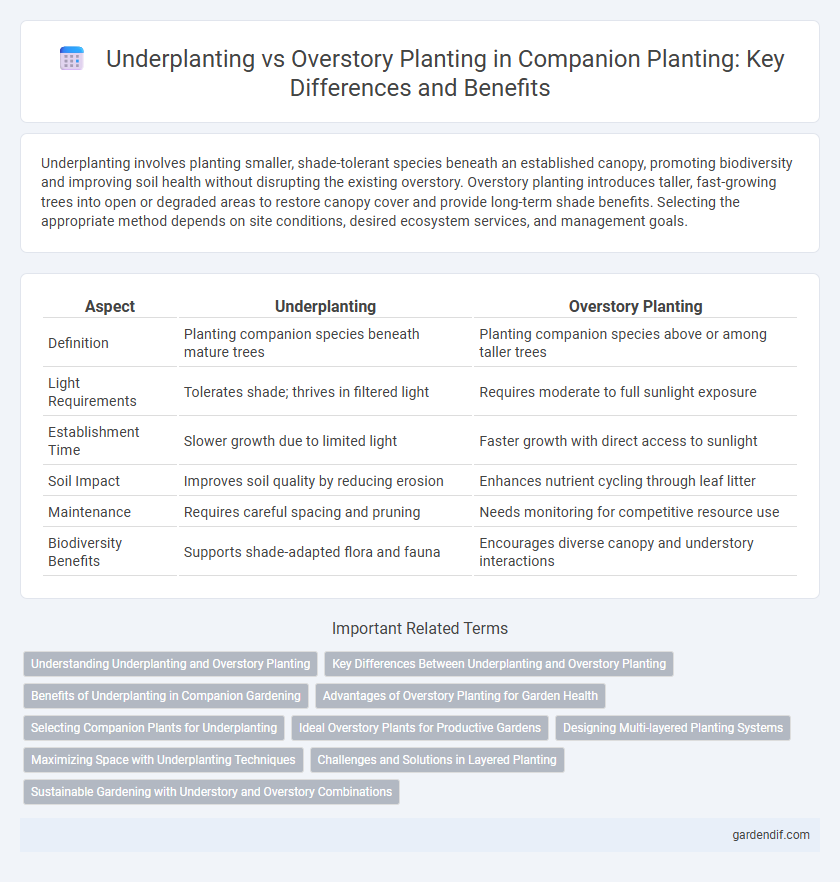
Underplanting vs Overstory Planting Illustration
Underplanting involves planting smaller, shade-tolerant species beneath an established canopy, promoting biodiversity and improving soil health without disrupting the existing overstory. Overstory planting introduces taller, fast-growing trees into open or degraded areas to restore canopy cover and provide long-term shade benefits. Selecting the appropriate method depends on site conditions, desired ecosystem services, and management goals.
Table of Comparison
| Aspect | Underplanting | Overstory Planting |
|---|---|---|
| Definition | Planting companion species beneath mature trees | Planting companion species above or among taller trees |
| Light Requirements | Tolerates shade; thrives in filtered light | Requires moderate to full sunlight exposure |
| Establishment Time | Slower growth due to limited light | Faster growth with direct access to sunlight |
| Soil Impact | Improves soil quality by reducing erosion | Enhances nutrient cycling through leaf litter |
| Maintenance | Requires careful spacing and pruning | Needs monitoring for competitive resource use |
| Biodiversity Benefits | Supports shade-adapted flora and fauna | Encourages diverse canopy and understory interactions |
Understanding Underplanting and Overstory Planting
Underplanting involves planting smaller trees or shrubs beneath an existing canopy, promoting biodiversity and enhancing habitat structure in forest ecosystems. Overstory planting refers to establishing taller, dominant trees that form the upper canopy layer, crucial for long-term forest development and carbon sequestration. Understanding the ecological roles and growth requirements of both underplanting and overstory planting supports sustainable forest management and companion planting strategies.
Key Differences Between Underplanting and Overstory Planting
Underplanting involves planting smaller vegetation beneath existing mature trees, enhancing biodiversity and improving soil health by utilizing shaded, protected microenvironments. Overstory planting refers to establishing tall, canopy-forming trees that dominate the landscape, creating shade and modifying microclimates over time. Key differences include light availability, with underplanting adapted to low-light understory conditions and overstory planting requiring open space for vertical growth, impacting ecosystem structure and species interactions.
Benefits of Underplanting in Companion Gardening
Underplanting in companion gardening enhances biodiversity by creating multiple plant layers that improve pest control and soil health. This technique maximizes space efficiency, allowing shade-tolerant plants to thrive beneath taller crops, which leads to higher overall yields. Improved microclimates from underplanting reduce water evaporation and help retain soil moisture, benefiting the entire garden ecosystem.
Advantages of Overstory Planting for Garden Health
Overstory planting enhances garden health by providing shade that reduces soil moisture evaporation and limits weed growth. It creates a microclimate favorable for understory plants, promoting biodiversity and improving pest resistance. The deep roots of overstory plants enhance soil structure and nutrient cycling, resulting in stronger, healthier plants throughout the garden ecosystem.
Selecting Companion Plants for Underplanting
Selecting companion plants for underplanting requires evaluating shade tolerance, root competition, and soil preferences to ensure harmony with the overstory. Shade-tolerant species like ferns, hostas, and woodland wildflowers thrive beneath taller canopy trees, benefiting from the filtered light and moisture retention. Properly matched companions improve biodiversity, suppress weeds, and enhance soil nutrients, creating a resilient layered ecosystem.
Ideal Overstory Plants for Productive Gardens
Ideal overstory plants for productive gardens include nitrogen-fixing trees like black locust and alder, which enhance soil fertility by enriching nitrogen levels. Fruit-bearing trees such as apple and pear provide shade and food while supporting underplanting of shade-tolerant vegetables and herbs like spinach and mint. Deep-rooted overstory species improve soil structure and moisture retention, creating a favorable microclimate for diverse companion plants beneath.
Designing Multi-layered Planting Systems
Designing multi-layered planting systems involves strategically combining underplanting with overstory planting to maximize biodiversity and ecological benefits. Underplanting enhances soil health and promotes understory species, while overstory planting provides shade, habitat, and structural diversity, creating a balanced companion planting environment. Effective integration of these layers supports nutrient cycling, pest control, and microclimate regulation in sustainable landscape design.
Maximizing Space with Underplanting Techniques
Underplanting techniques maximize garden space by planting shade-tolerant species beneath established trees, creating layered vegetation that enhances biodiversity and soil health. This method optimizes light usage and root zone distribution, increasing overall productivity without competing with the overstory's resources. Effective pairing of underplanted companions can suppress weeds, improve moisture retention, and support beneficial pollinators within the ecosystem.
Challenges and Solutions in Layered Planting
Underplanting faces challenges such as limited light availability and root competition from overstory plants, often resulting in slower growth and higher mortality rates for understory species. Solutions include selecting shade-tolerant companion plants, optimizing planting density, and improving soil conditions through mulching and targeted irrigation. Overstory planting challenges revolve around ensuring that overstory species do not overly dominate resources, which can be mitigated by careful species selection and staggered planting schedules to balance growth dynamics in layered planting systems.
Sustainable Gardening with Understory and Overstory Combinations
Underplanting and overstory planting create sustainable garden ecosystems by mimicking natural forest layers, enhancing biodiversity and soil health. Understory plants thrive in the shade of taller overstory trees, reducing water needs and suppressing weeds while contributing to nutrient cycling. Combining diverse species in these layers promotes resilient landscapes that support pollinators and improve pest management naturally.
Underplanting vs Overstory Planting Infographic

 gardendif.com
gardendif.com